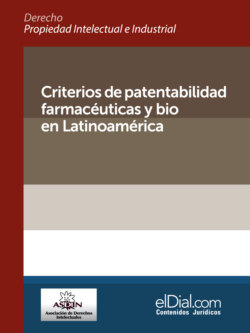Читать книгу Criterios de patentabilidad farmacéuticas y bio en Latinoamérica - Fernando Garcia - Страница 5
На сайте Литреса книга снята с продажи.
ОглавлениеResumen
La aprobación del tratado internacional ADPIC/OMC1 vigente desde 1995 estableció como principio rector que las patentes pueden obtenerse para las invenciones en todos los campos de la tecnología, artículo 27, párrafo1, con lo cual se terminó con la exclusión de las patentes farmacéuticas practicada por los países en desarrollo. Al mismo tiempo consagró el principio de la protección de la información científico-tecnológica que debe desarrollarse para el registro sanitario de medicamentos, artículo 39.3.2 La promoción de la utilización de las “flexibilidades” del ADPIC –en realidad cláusulas de salvaguarda para hacer frente a situaciones de emergencia o abusos en la posición dominante del mercado– llega a tales extremos en algunos países que violan el principio de que las patentes pueden obtenerse para las invenciones en todos los campos de la tecnología.
La región latinoamericana tiene un problema de muy larga data que es necesario enfrentar: no ha logrado cerrar la brecha tecnológica, no sólo con el primer mundo, sino tampoco con Asia; por el contrario, esta brecha se continúa ampliando.
Se reseñan las agrias controversias que generan las patentes farmacéuticas (medicamentos en base a moléculas obtenidas por síntesis química) y las patentes biotecnológicas (medicamentos en base a moléculas grandes obtenidas por biotecnología), así como las variadas investigaciones que vinculan un régimen vigoroso de respeto y observancia a estas herramientas de la propiedad industrial con el crecimiento y la salud.
Se concluye que las prohibiciones e inflexibles restricciones que se imponen con más o menos severidad en varios países de la región a las diversas formas que asumen las patentes farmacéuticas y bio (como por ejemplo la prohibición de patentar nuevos usos) –creando así murallas a la transferencia de tecnología, inversiones y desincentivando la creación de ciencia y tecnología nacionales– deberían ser reemplazadas por el examen de caso por caso para determinar si cada solicitud de patentes cumple con los tres requisitos exigibles para ser considerada invento protegible: novedad, altura inventiva (no obviedad) y aplicación industrial.
Abstract
The approval of the TRIPS / WTO international treaty in force since 1995 established as a guiding principle that patents can be obtained for inventions in all fields of technology, article 27, paragraph 1, which ended with the exclusion of pharmaceutical patents practiced by developing countries. At the same time, it enshrined the principle of the protection of scientific and technological information that must be developed for the sanitary registration of medicines, article 39.3. The promotion of the use of “Flexibilities” of TRIPS - in reality, safeguard clauses to deal with emergency situations or abuses in the dominant position of the market - reaches such extremes in some countries that violate the principle that patents can be obtained for inventions in all fields of technology.
The Latin American region has a very long-standing problem that needs to be addressed: it has not managed to close the technological gap, not only with the first world, but with Asia; On the contrary, this gap continues to widen. The publication outlines the bitter controversies generated by pharmaceutical patents (medicines generally obtained by synthesis) and biotechnological patents (medicines with big molecules obtained through bioengineering) as well as the varied research that links a vigorous regime of respect and observance of these tools of industrial property with growth and health.
It is concludes that the prohibitions and inflexible restrictions that are imposed with more or less severity in several countries of the region to the different forms assumed by pharmaceutical and bio patents (such as the prohibition to patent new uses) - thus creating walls to the transfer of technology, investments and discouraging the creation of national science and technology - should be replaced by the case-by-case examination to determine whether each patent application meets the three requirements to be considered an invention: novelty, inventive step (no obviousness ) and industrial application.
